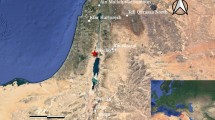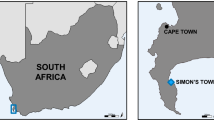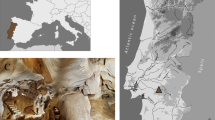Abstract
Natural sciences provide several modern methodologies that could be successfully applied in archaeological studies. In this pilot study, archaeological human remains from two Iron Age cemeteries (7th–twelfth centuries AD), Lejasbitēni and Čunkāni-Dreņģeri, which are located in different regions of Latvia, were studied. We applied ancient DNA (aDNA) and tooth enamel peptide analysis to determine the biological sex of the individuals. In addition, aDNA analysis was used to perform mtDNA haplogroup analysis. In most cases, the results of aDNA analysis regarding the biological sex of individuals coincided with the gender assigned based on grave orientation and grave goods. The results of sex determination using peptide analysis in all four individuals for whom data were available matched the possible gender. Of the 17 samples that had sufficient DNA for sequencing, seven samples had enough reads to perform mtDNA haplogroup analysis. The H2a2a, I4a1, H2a2a1, and H16c mtDNA haplogroups were identified in the individuals from the Lejasbitēni cemetery, while the T2b and K1a + 150 mtDNA haplogroups were identified in the individuals from the Čunkāni-Dreņģeri cemetery. Overall, the obtained results demonstrated the feasibility of applying aDNA and tooth enamel peptide analysis for biological sex determination within archaeological studies. The availability of human aDNA data will be highly useful for investigating the demographic history and social structures in Iron Age Latvia.


Similar content being viewed by others
References
Bruzek J. A method for visual determination of sex, using the human hip bone. Am J Phys Anthropol. 2002;117:157–68.
White TD, Black MT, Folkens PA. Human osteology. 3rd ed. San Diego, CA: Academic Press; 2011.
Cox M. Ageing adults from the skeleton. In M. Cox and S. Mays (eds), Human Osteology in Archaeology and Forensic Science, London; 2000. pp. 61–82.
Lewis M. The Bioarchaeology of Children: Perspectives from Biological and Forensic Anthropology. Cambridge, UK: Cambridge Univ Press; 2007.
Walker PL, Cook DC. Brief communication: gender and sex: vive la difference. Am J Phys Anthropol. 1998;106:255–9.
Bauer CM, Niederstätter H, McGlynn G, Stadler H, Parsona W. Comparison of morphological and molecular genetic sex-typing on mediaeval human skeletal remains. Forensic Sci Int Genet. 2013;7:581–6.
Schmidt D, Hummel S, Herrmann B. Brief communication: multiplex X/Y-PCR improves sex identification in aDNA analysis. Am J Phys Anthropology. 2003;121:337–42.
Gibbon V, Paximadis M, Strkalj G, Ruff P, Penny C. Novel methods of molecular sex identification from skeletal tissue using the amelogenin gene. Forensis Sci Int Genet. 2009;3:74–9.
Bollongino R, Tresset A, Vigne J-D. Environment and excavation: pre-lab impacts on ancient DNA analyses. CR Palevol. 2008;7:91–8.
Masuyama K, Shojo H, Nakanishi H, Inokuchi S, Adachi N. Sex Determination from Fragmented and Degenerated DNA by Amplified Product-Length Polymorphism Bidirectional SNP Analysis of Amelogenin and SRY Genes. PLoS ONE. 2017;12(1): e0169348.
Skoglund P, Storå J, Götherström A, Jakobsson M. Accurate sex identification of ancient human remains using DNA shotgun sequencing. J Archaeol Sci. 2013;40:4477–82.
Knipper C, Mittnik A, Massy K, Kociumaka C, Kucukkalipci I, Maus M, Wittenborn F, Metz SE, Staskiewicz A, Krause J, Stockhammer PW. Female exogamy and gene pool diversification at the transition from the Final Neolithic to the Early Bronze Age in central Europe. Proc Natl Acad Sci USA. 2017;114:10083–8.
Mittnik A, Wang C-C, Svoboda J, Krause J. A molecular approach to the sexing of the triple burial at the upper paleolithic site of Dolní Věstonice. PLoS ONE. 2016;11(10): e0163019.
Stewart NA, Gerlach RF, Gowland RL, Gron KJ, Montgomery J. Sex determination of human remains from peptides in tooth enamel. Proc Natl Acad Sci USA. 2017;114:13649–54.
Gowland R, Stewart NA, Crowder KD, Hodson C, Shaw H, Gron KJ, Montgomery J. Sex estimation of teeth at different developmental stages using dimorphic enamel peptide analysis. Am J Phys Anthropol. 2021;174:859–69.
Merheb M, Matar R, Hodeify R, Siddiqui SS, Vazhappilly CG, Marton J, Azharuddin S, Al ZH. Mitochondrial DNA, a powerful tool to decipher ancient human civilization from domestication to music, and to uncover historical murder cases. Cells. 2019;8:433.
Översti S, Majander K, Salmela E, Salo K, Arppe L, Belskiy S, Etu-Sihvola H, Laakso V, Mikkola E, Pfrengle S, Putkonen M, Taavitsainen JP, Vuoristo K, Wessman A, Sajantila A, Oinonen M, Haak W, Schuenemann VJ, Krause J, Palo JU, Onkamo P. Human mitochondrial DNA lineages in Iron-Age Fennoscandia suggest incipient admixture and eastern introduction of farming-related maternal ancestry. Sci Rep. 2019;9:16883.
Vasks A. The pre-history of Latvia (10500 BCE - 1200 CE). Latvia and Latvians: Collection of scholarly articles, Vol. 2, Part 3. Rīga: Latvian Academy of Sciences; 2018. pp. 9–39.
Brink S, Price N. The Viking world. Oxfordshire: Routledge; 2008.
Atgāzis, M. Vidējais dzelzs laikmets, 400.-800.g. [Middle Iron Age, 400–800 ADCE]. Latvijas senākā vēsture. Rīga: Latvijas vēstures institūta apgāds; 2001.
Urtāns V. Etniskās atšķirības apbedīšanas tradīcijās un kapu inventārā 5. - 9. gs [Ethnic differences in burial traditions and grave inventories in the 5th - 9th centuries AD]. Arheoloģija un etnogrāfija, 9. laidiens. Rīga; 1970. pp 105–125, 61–83.
Atgāzis M. Dreņģeru-Čunkānu kapulauks un zemgaļu senvēstures pētniecības jautājumi [Dreņģeri-Čunkāni cemetery and the history of ancient Semigallian culture]. Zinātniskās atskaites sesijas materiāli par arheologu 1992. un 1993. gada pētījumu rezultātiem. Riga: Zinātne; 1994. pp. 23–30.
Buikstra JE, Ubelaker DH. Standards for data collection from human skeletal remains. In J. E. Buikstra & D. H. Ubelaker (Eds.), Fayetteville: Arkansas Archeological Survey Research Series No 44; 1994.
AlQahtani SJ, Hector M, Liversidge H. Brief communication: the London atlas of human tooth development and eruption. Am J Phys Anthropol. 2010;142:481–90.
Šnē A. Sabiedrība un vara: Sociālās attiecības Austrumlatvijā aizvēstures beigās [Society and power: social relations in eastern Latvia in the end of prehistory]. Rīga: Intelekts; 2002.
Keyser-Tracqui C, Ludes B. Methods for the study of ancient DNA. Methods Mol Biol. 2005;297:253–64.
Andrews S. FastQC: a quality control tool for high throughput sequence data. [cited 2022 May 30]. Available online at: http://www.bioinformatics.babraham.ac.uk/projects/fastqc.
Ewels P, Magnusson M, Lundin S, Käller M. MultiQC: Summarize analysis results for multiple tools and samples in a single report. Bioinformatics. 2016;32:3047–8.
Bolger AM, Lohse M, Usadel B. Trimmomatic: a flexible trimmer for Illumina sequence data. Bioinformatics. 2014;30(15):2114–20.
Li H. Aligning sequence reads, clone sequences and assembly contigs with BWA-MEM. arXiv. 2013; arXiv:1303.3997v2.
Li H, Handsaker B, Wysoker A, Fennell T, Ruan J, Homer N, Marth G, Abecasis G, Durbin R. 1000 Genome project data processing subgroup author notes. The sequence alignment/map format and SAMtools. Bioinformatics. 2009;25:2078–9.
Seeman T. https://github.com/tseemann/samclip. 2018. [cited 2022 May 30].
Jónsson H, Ginolhac A, Schubert M, Johnson P, Orlando L. mapDamage2.0: fast approximate Bayesian estimates of ancient DNA damage parameters. Bioinformatics. 2013;29:1682–4.
Weissensteiner H, Pacher D, Kloss-Brandstätter A, Forer L, Specht G, Bandelt H, Kronenberg F, Salas A, Schönherr S. HaploGrep 2: mitochondrial haplogroup classification in the era of high-throughput sequencing. Nucleic Acids Res. 2016;44:W58-63.
Lewis M. The bioarchaeology of children: Perspective from biological and forensic anthropology. Cambridge: Cambridge University Press; 2007.
Scheuer L, Black S. Developmental juvenile osteology. In L. Scheuer & S. B. T.-D. J. O. Black (Eds.). Cambridge, MA: Academic Press; 2000.
Işcan MY, Derrick K. Determination of sex from the sacroiliac joint: a visual assessment technique. Florida scientist. 1984;47:94–8.
Phenice TW. A newly developed visual method of sexing the os pubis. Am J Phys Anthropol. 1969;30:297–301.
Walker PL. Problems of preservation and sexism in sexing: some lessons from historical collections for palaeodemographers. In: Herring A, Saunders SR, editors. Grave Reflections: Portraying the Past through Cemetery Studies. Toronto: Canadian Scholars’ Press; 1995. p. 31–44.
Radiņš A. 10. –13. gadsimta senkapi latgaļu apdzīvotajā teritorijā un Austrumlatvijas etniskās, sociālās un politiskās vēstures jautājumi [Ancient cemeteries from the 10th – 13th centuries AD in the Latgalian territories, and the ethnic, social, and political issues of the eastern Latvia]. Latvijas Vēstures Muzeja raksti Nr. 5: Arheoloģija. Rīga: N.I.M.S.; 1999. pp. 25–7.
Stratton S. “Seek and you shall find.” How the analysis of gendered patterns in archaeology can create false binaries: a case study from Durankulak. J Archaeol Method Th. 2016;23:854–69.
Afonso C, Nociarova D, Santos C, Martinez-Labarga C. Sex selection in late Iberian infant burials: Integrating evidence from morphological and genetic data. Am J Hum Biol. 2019;31: e23204.
Hagelberg E, Hofreiter M, Keyser C. Ancient DNA: the first three decades. Philos Trans R Soc Lond B Biol Sci. 2015;370(1660):20130371.
Stone AC, Milner GR, Pääbo S, Stoneking M. Sex determination of ancient human skeletons using DNA. Am J Phys Anthropol. 1996;99:231–8.
Key FM, Posth C, Krause J, Herbig A, Bos KI. Mining Metagenomic Data Sets for Ancient DNA: Recommended Protocols for Authentication. Trends Genet. 2017;33:508–20.
Dabney J, Meyer M, Pääbo S. Ancient DNA damage. Cold Spring Harb Perspect Biol. 2013;5(7): a012567. https://doi.org/10.1101/cshperspect.a012567.
Hansen HB, Damgaard PB, Margaryan A, Stenderup J, Lynnerup N, Willerslev E, Allentoft ME. Comparing ancient DNA preservation in petrous bone and tooth cementum. PLoS ONE. 2017;12: e0170940.
Damgaard PB, Margaryan A, Schroeder H, Orlando L, Willerslev E, Allentoft ME. Improving access to endogenous DNA in ancient bones and teeth. Sci Rep. 2015;5:11184.
Buonasera T, Eerkens J, de Flamingh A, Engbring L, Yip J, Li H, Haas R, DiGiuseppe D, Grant D, Salemi M, Nijmeh C, Arellano M, Leventhal A, Phinney B, Byrd BF, Malhi RS, Parker G. A comparison of proteomic, genomic, and osteological methods of archaeological sex estimation. Sci Rep. 2020;10(1):11897.
Parker GJ, Yip JM, Eerkens JW, Salemi M, Durbin-Johnson B, Kiesow C, Haas R, Buikstra JE, Klaus H, Regan LA, Rocke DM, Phinney BS. Sex estimation using sexually dimorphic amelogenin protein fragments in human enamel. J Archaeol Sci. 2019;101:169–80.
Acknowledgements
We are grateful to Dr Nicolas Stewart (School of Pharmacy and Biomolecular Sciences, University of Brighton) for generating and interpreting the amelogenin peptide results. We would also like to thank the anonymous reviewers for their valuable comments and edits, with their input considerably improving this manuscript.
Funding
This research was funded by the Latvian Council of Science, project No. lzp-2018/1–0395.
Author information
Authors and Affiliations
Corresponding author
Ethics declarations
Competing Interests
The authors declare no competing interests.
Additional information
Publisher's Note
Springer Nature remains neutral with regard to jurisdictional claims in published maps and institutional affiliations.
Supplementary Information
Below is the link to the electronic supplementary material.
Rights and permissions
Springer Nature or its licensor (e.g. a society or other partner) holds exclusive rights to this article under a publishing agreement with the author(s) or other rightsholder(s); author self-archiving of the accepted manuscript version of this article is solely governed by the terms of such publishing agreement and applicable law.
About this article
Cite this article
Kimsis, J., Petersone-Gordina, E., Poksane, A. et al. Application of natural sciences methodology in archaeological study of Iron Age burials in Latvia: pilot study. Forensic Sci Med Pathol 19, 8–15 (2023). https://doi.org/10.1007/s12024-022-00553-7
Accepted:
Published:
Issue Date:
DOI: https://doi.org/10.1007/s12024-022-00553-7




